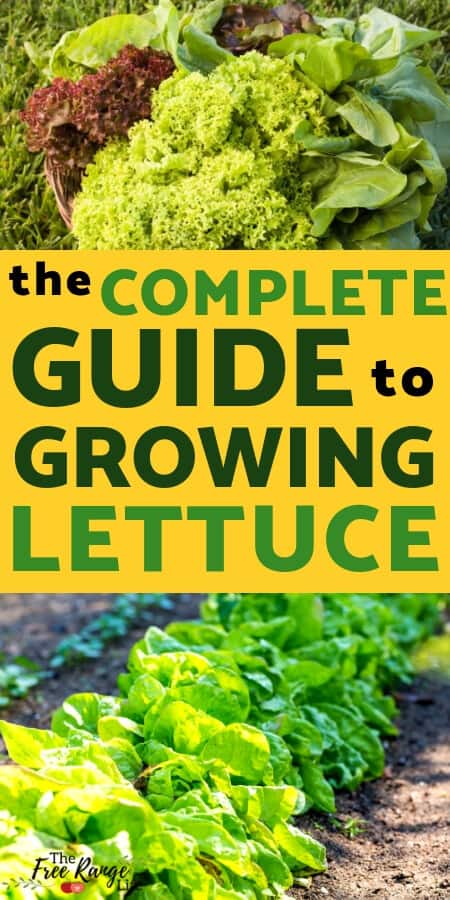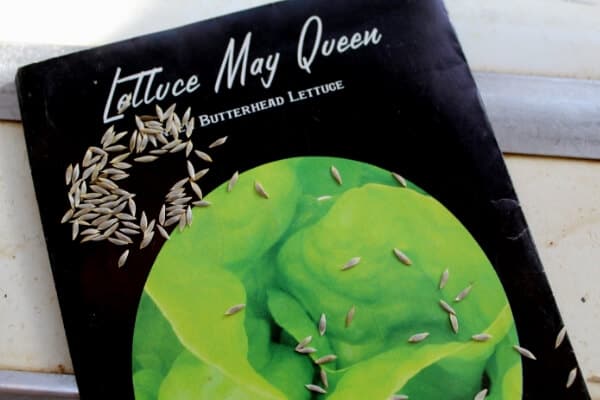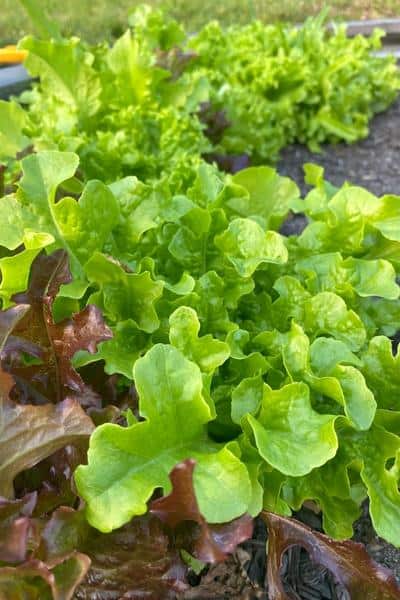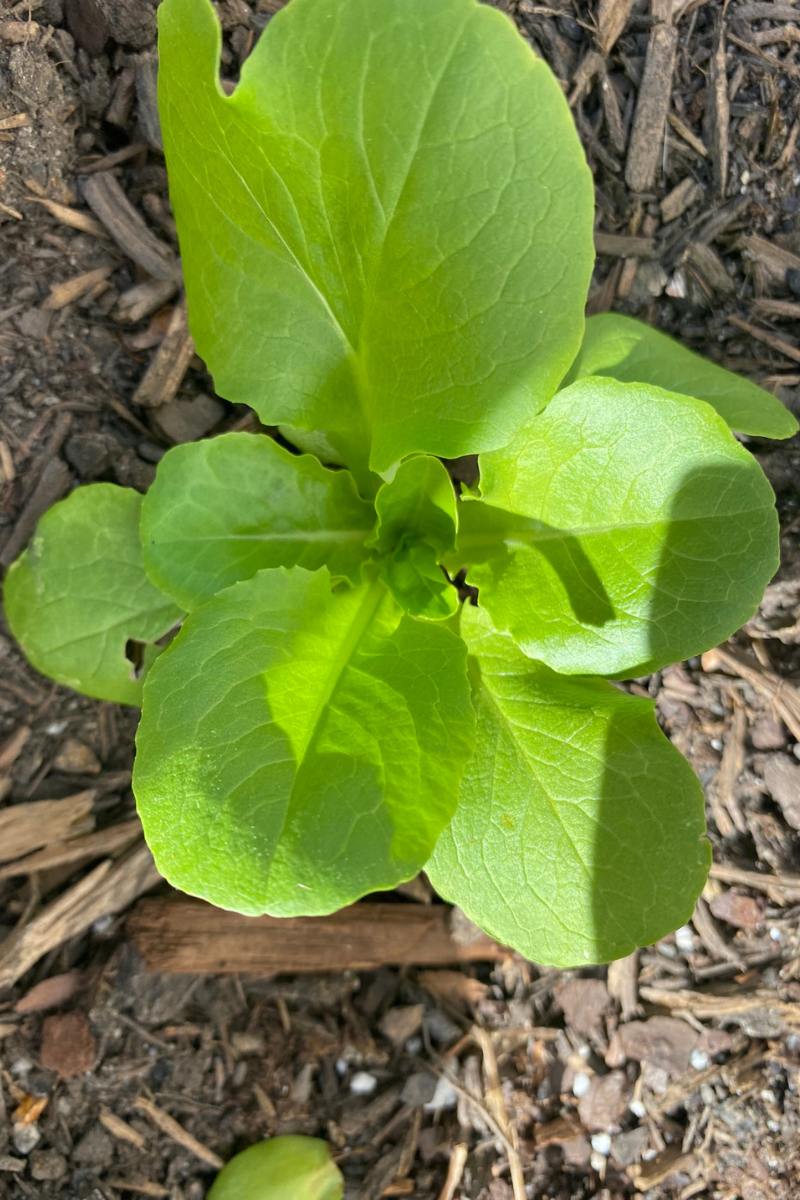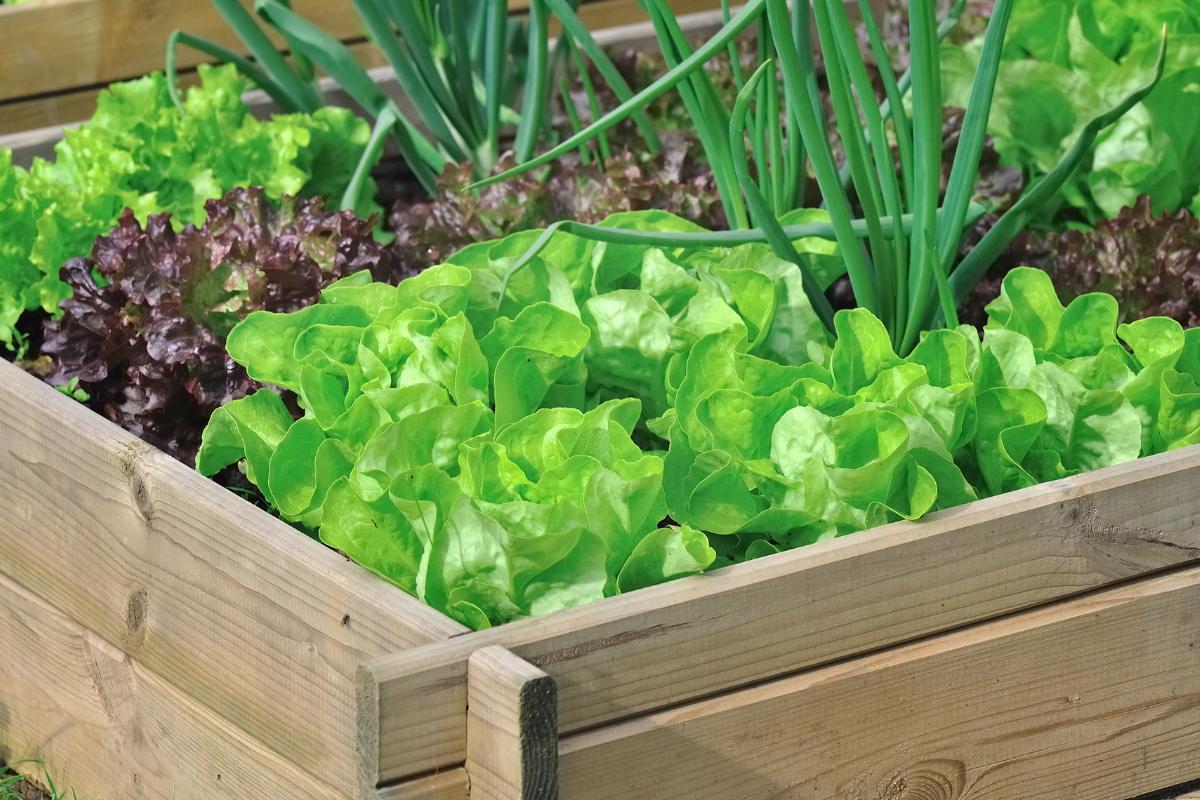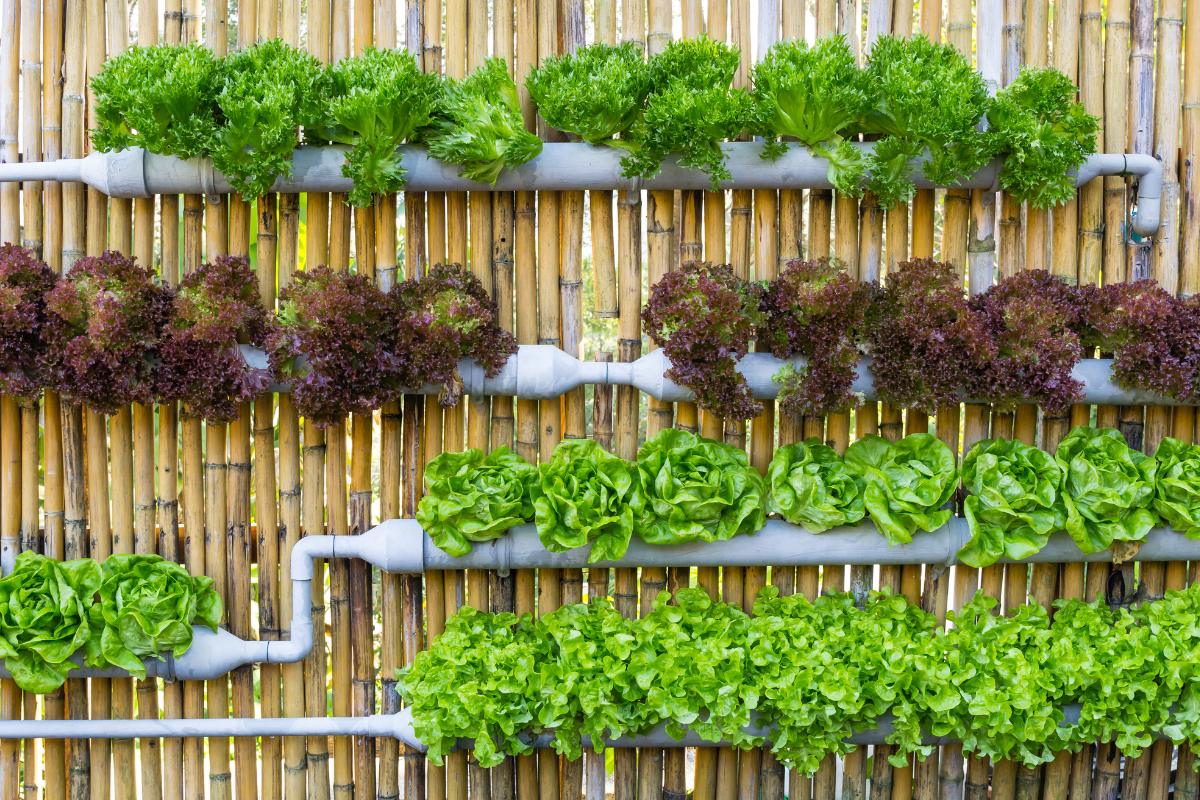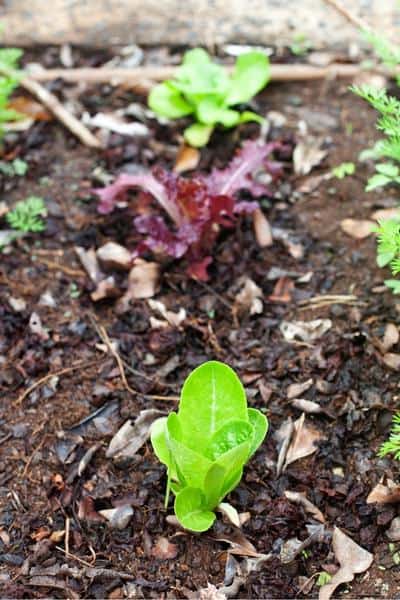Lettuce is a great, easy to grow crop for the garden. It’s suitable for almost all areas, and can be easily grown from seed
Homegrown lettuce is so much tastier- and you can grow lettuce varieties that go past just romaine or iceberg lettuce!
This site contains affiliate links. If you make a purchase using one of these links, I may earn a commission. Please see my disclosure page for more information about cookies collected and our privacy policy.
Whether you want to enjoy daily salads or top your favorite sandwich or burger, it’s worth learning how to grow lettuce in your backyard garden (or container garden!)
How to Grow Lettuce From Seed
Growing lettuce seeds is much cheaper than plant starts (or buying store bought lettuce!) and it’s so easy! Once you start growing your own lettuce from seed, you’ll never go back to buying lettuce at the grocery store again.
Planting lettuce seeds is a very straightforward and simple process. There are different methods you can use, but this guide will show you the best way to start and grow lettuce seeds at home.
Lettuce can be started inside in pots and transplanted into the garden or it can be direct seeded. You can even winter-sow it!
Because lettuce seeds are small and germinate very quickly, I find the best way to plant lettuce seeds is to directly seed them into the garden. This means you don’t have to worry about transplanting tiny seedlings or transplant shock.
Lettuce is a cool weather crop. This means it prefers cool temperatures and dislikes hot weather. You can grow lettuce both in the early spring and the fall, or even through the winter, depending on your growing zone.
To get started, direct seed your lettuce into the garden 2-3 weeks before your last frost date in the early spring.
Young plants can handle a light frost, but are more tender when they are very small. More mature lettuce plants can handle a lower temperatures and frost, but if the temperatures are too cold or you are getting daily frosts, you’ll need to protect your plants.
If you want to get a head start you can use row covers or a cold frame to give the tender seedlings protection from frost and also warm the soil a little bit. These row covers can allow you to start your lettuce seeds a few weeks earlier as well.
Lettuce seeds are very small, and need some light to germinate, so you don’t want to sow the seeds very deep. Simply sprinkle them in your bed or rows and then gently rake the soil so that they are barely covered.
Don’t worry about spacing at this point, you can thin your lettuce seedlings as they grow.
Your lettuce seeds should sprout in 2 days to 2 weeks depending on soil temperature, water, and light conditions.
Varieties of Lettuce to Grow
There are lots of types of lettuce to choose from when growing lettuce from seed. You can choose from head lettuce varieties or loose leaf varieties. I prefer loose leaf or loose head, as it tends to be grow more quickly and easily, and it is more of a come and cut again variety of lettuce.
Some head lettuce varieties to try are: Buttercrunch , May Queen Lettuce, Butter King,
Some loose leaf lettuce varieties to try are: Romaine lettuce, Red Romaine,
Some other considerations when choosing a type of lettuce, is your climate. If you live in a warmer climate you should look for heat tolerant or bolt resistant lettuce types. These types can handle warmer temperatures better and will extend your harvest season.
How to Care for Your Growing Lettuce Plants
How Far Apart to Plant Lettuce
As your seedlings grow you will need to thin the young lettuce plants to ensure that they get enough space, air circulation, and nutrients to their roots.
How far apart your final spacing is will depend on the type of lettuce you are growing:
- Head lettuce will need a final spacing of about 8-10 inches per head.
- Loose leaf lettuces and baby head lettuce can be planted more closely, about 4-6 inches apart- but still ensure they have enough circulation around them to prevent disease.
If you aren’t sure which type of lettuce you have, the seed packet is a wealth of information. It will tell you how far apart the exact variety you have should be.
The great thing about thinning lettuce is that you can enjoy these first lettuce leaves in early spring salads and meals!
Lettuce Pests
There aren’t too many pests when it comes to lettuce. Aphids, slugs, rabbits, and deer are about it.
Aphids aren’t usually too big of a problem. Make sure you plant some flowers and herbs to draw in beneficial insects like ladybugs for natural pest control.
If slugs are a problem you can sprinkle diatomaceous earth around the plants or set out some slug traps to get rid of the slugs.
If large predators such as deer or rabbits are an issue, you may have to take steps to protect your lettuce plants. This could mean using fencing or chicken wire. Or using hoops or row covers.
How to Water Lettuce
As your lettuce seedling are growing, you will need to make sure the soil is kept evenly moist at all times. This helps them develop their root system and bring up nutrients.
Too much water can cause issues with disease or rot. A moisture gauge can be helpful if you aren’t sure if you are watering correctly. Keep the soil moist and watch for signs of wilting in your lettuce plants.
Here is more information on watering: How to Correctly Water Your Garden
Succession Planting Lettuce
Lettuce is the perfect crop for succession planting. Because it grows fast, you can plant new plantings every couple weeks to keep up a lettuce harvest all spring long.
To have a continuous lettuce harvest all spring long make succession plantings ever 2 weeks until the weather it too hot for proper germination. Once the weather starts to cool off in the late summer or fall, you can resume your plantings for another harvest!
Planting lettuce in the shade off your other taller plants, such as corn, tomatoes, or potatoes, can help extend their growing season a bit more as well.
Plant a fall crop of lettuce in August or September, and enjoy garden fresh lettuce until hard frosts hit!
How and When to Harvest Lettuce
Lettuce is best harvested when it is still young and tender. The flavor will be much more mild and sweet, and not at all bitter.
Many loose leaf lettuce varieties can be harvested as soon as the leaves are 3-4 inches tall (or before if you are thinning your plants)
To harvest leaf lettuce just take the outer leaves, and your plants will continue to grow. This is often referred to as “come and cut again” lettuce since you can continue to harvest until the weather is too warm and the plant bolts.
To harvest head lettuce, you can also harvest the outer leaves as well, if you don’t have a need for an entire head at once.
Other methods of harvesting head lettuce is to dig up the entire plant or cut the plant off above the soil. If using the latter, the plant may continue to grow and give you another small harvest.
Lettuce is best harvested early in the morning, when it is sweetest.
Store your lettuce in the refrigerator in a plastic bag or container. It should keep up to 10 days- though during the growing season it’s best to just pick what you need when you need it.
For some tips on keeping lettuce fresh check out this article which tells you how to keep lettuce fresh up to 5 weeks.
How to Grow Lettuce in Containers
Lettuce is an easy crop that doesn’t require a lot of space or full sun making it perfect for container gardens!
I have grown lettuce in long window boxes on a deck with no problems.
Lettuce has shallow roots, so it doesn’t need very deep containers or a lot of soil.
Because space is more of an issue in containers, choose loose leaf lettuce varieties that can be planted much more closely.
Choose a container that is at least 6 inches deep with good drainage holes.
Other than this, growing lettuce in a container is much the same as in a garden bed.
Because lettuce does not require pollination, you can also successfully grow lettuce indoors in containers. You will need a sunny window or a grow light set up but you can enjoy fresh lettuce year round with just a little prep work!
Lettuce is perfectly suited for growing aeroponically in a container like a Tower Garden. These amazing towers are perfect for crops like lettuce and can even be grown year round inside with grow lights.
Related Reading: 21 Crops You Can Grow in Containers
Growing Lettuce from Seed FAQ
How long does it take for lettuce seeds to germinate?
Lettuce seeds can take anywhere from 2 days to 2 weeks to germinate. For the fastest germination make sure that your seeds have light, moist soil, and that the soil temperature is around 60F.
What do lettuce seedlings look like?
The first set of leaves you will see are the seed leaves. They are 2 very small, oblong leaves. The next leaves are the first true leaves- and they look almost exactly like a tiny lettuce plant.
Can lettuce be grown in the shade?
While lettuce grows best in full sun (6+ hours of sunlight per day) it can grow in partial shade (3-4 hours of sun). If you choose to grow lettuce in partial shade, it’s best to choose loose-leaf lettuce varieties for the best result and quickest harvest.
How do you transplant lettuce seedlings?
To transplant lettuce seedling into the garden, simply plant the plants in the soil keeping the soil level the same. Plant the seedlings at their final spacing as indicated above. Water the seedlings well at planting time to reduce transplant shock.
How many lettuce seeds do you plant per hole?
I don’t really make holes for lettuce seeds, I sprinkle the seeds in a row or grid since I know that I will be thinning later. If your seeds are old, you may want to double up on the number of seeds you plant since germination rates can decrease with age.
How deep do you plant lettuce seeds?
Lettuce seeds are planted on the soil surface and barely covered with soil.
Do lettuce seeds need light to germinate?
Yes, lettuce seeds need light to germinate. If you plant them too deep, they may not sprout. If you are starting seeds indoors, be sure that the trays have a grow light or a sunny window nearby to ensure germination.
Why aren’t my lettuce seeds germinating?
If you’re seeds aren’t germinating it’s likely one of the following: Your seeds are too old. You planted the seeds to deep. You over or underwatered your seeds. The temperature is too hot or cold for proper germination.
Other Growing Guides:
How to Grow Eggplant from Seed to Harvest
The Ultimate Guide to Growing Squash
The Complete Guide to Growing Tomatoes

